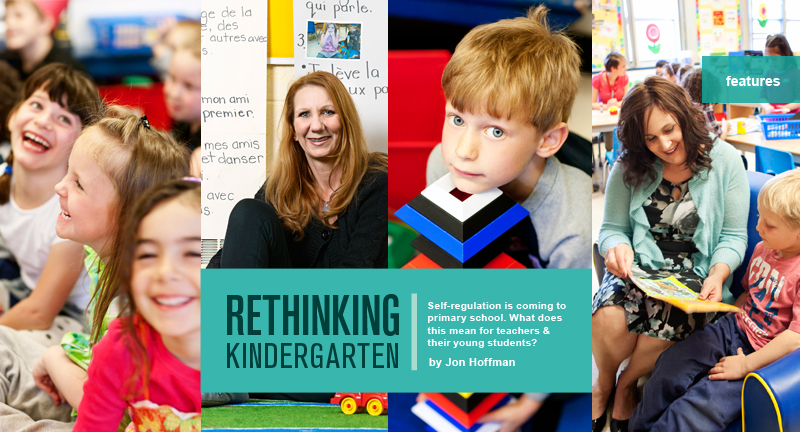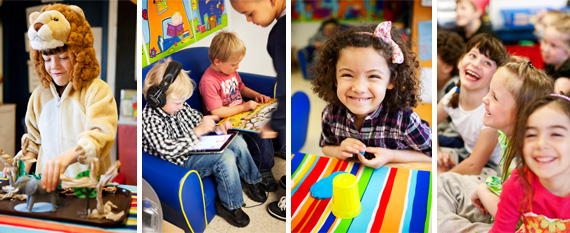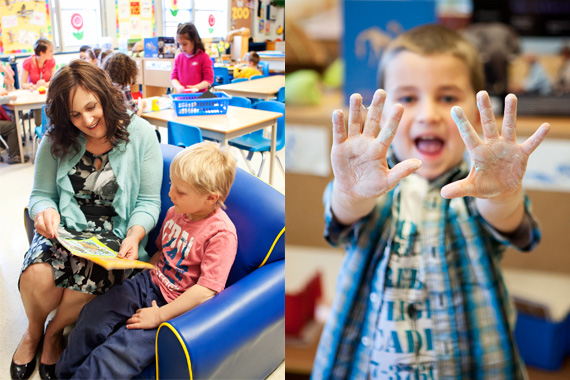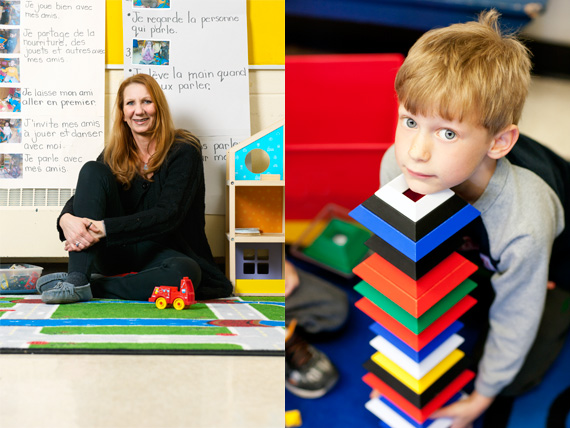
IT’S CIRCLE TIME in Ms. Slee’s all-day kindergarten class at Memorial Public School in St. Catharines. Before getting started, Allyson Slee, OCT, has her 28 students march on the spot for one minute — except for one girl who is across the room sitting alone on a soft chair reading and listening to quiet music.
Later, as the children work at nine different learning centres, early childhood educator Shirley Delaney takes one fidgety boy aside. “How is your engine running right now?” she asks. “Too fast, too slow or just right?” Meanwhile, Slee assesses another child using her school board’s new kindergarten screening checklist, which includes items such as:
- participates in messy activities (for example, gluing, painting, craft activities) without distress
- tolerates loud or unexpected noise within the environment
- stays regulated when participating in physical activities.
Regulated? That’s right: The marching and checklist are tools to help teachers in the DSB of Niagara improve “self-regulation” in kindergarten students. If you haven’t heard of self-regulation yet, you will, as Ontario’s new all-day learning curriculum — which lists building self-regulation as a core goal — rolls out over the next few years.
At a basic level, self-regulation is the ability to adapt your mental, emotional and physiological state to the task at hand. If a child needs rest, he should wind down toward sleep. If he’s in the road with a car bearing down, he needs to get out of the way fast. In school, self-regulation enables children to get along with people, control their behaviour and be in the calm-but-alert-and-focused state conducive to learning.
“IQ was the predictor of success in the 20th century. In the 21st century, self-regulation will be the predictor of success,” says Stuart Shanker, distinguished research professor of philosophy and psychology at York University and one of Canada’s leading experts on self-regulation. Genes and temperament impact the development of self-regulation, but the key idea for kindergarten teachers is that children with poor self-regulation struggle to cope with ordinary classroom stimulation: sights, background noises, textures, emotions, what other children are doing and saying. “When a child is putting so much energy into coping,” says Shankar, “there is little left over for paying attention, controlling impulses, remembering instructions and ultimately for learning.”
Canadian and American data suggest that between 25 and 50 per cent of children going into Grade 1 struggle to varying degrees with self-regulation. “That’s why it’s crucial to focus on it in kindergarten,” Shanker says. Here are four ways to build self-regulation in the classroom.
1. A program that emphasizes play

Time for learning together on the carpet tends to run more smoothly when kindergartners have the chance to engage in activities suited to their physical and emotional states. For one, that might mean tactile play with playdough; for another, it means dress-up; still others may seek something quieter.
Play-based learning is old news in kindergarten programs. What’s becoming increasingly accepted is that play promotes self-regulation as well as cognitive learning.
“During make-believe play, children must follow social rules that they and their playmates make,” says Laura Berk, distinguished professor emerita of developmental psychology at Illinois State University. “They must stay in character, take turns and adjust to the twists and turns of the plot. This builds their ability to follow social rules in everyday life, which benefits both academic and social learning.” An important role for kindergarten teachers, says Berk, is to “scaffold or support children by offering new ideas and possibilities so their make-believe play gradually becomes more sophisticated.”
Learning about self-regulation has prompted Chantal Stephens, OCT, a kindergarten teacher at école élémentaire catholique Sainte-Marguerite-Bourgeoys, to rethink her role when her students aren’t getting along.
“Two years ago, when children were fighting over a toy, I’d move in and say who got to have the red truck, for how long and who would get it next,” says Stephens. Now she spends more time helping children develop their own solutions. “I’ll say, ‘I’ve noticed that there is a lot of conflict around the red truck. Let’s talk about sharing.’” She’ll ask the children what sharing means and how sharing can work. “Usually children come up with their own rules.”
Children are allowed to doodle, chew gum or play with pieces of yarn that are tied to the leg of each desk.
2. Set the stage

Because the students in Allyson Slee’s kindergarten class have a variety of activities to engage them, she is able to find that all-important one-on-one time for children when they need it.
When she first heard about self-regulation, Slee’s first thought was, “I’m already doing a lot of this.” And, like a lot of kindergarten teachers, she was. But one insight Slee gained is that changing from one activity to another goes more smoothly if she has her students do a short physical activity beforehand. “If I were to say, ‘Tidy up your activity and go out into the hall to get your snack,’ students would be bumping into each other and it would be generally chaotic. Now I bring the children together for some brief physical activity like stretching, head, shoulders, knees and toes or a fingerplay. After that, snack time is much more orderly.”
This comes as no surprise to Brenda Whittam-Neary, a speech-language pathologist in Regina, Saskatchewan. Whittam-Neary works with teachers at Kitchener Community School, where several self-regulation classrooms have been in place for four years. “Functional MRIs have shown that movement increases oxygen and glucose in the brain. Those are the brain’s foods,” she says. “Sitting still can actually have a detrimental effect on children’s ability to concentrate and take in information.”
Occupational therapist Patti McGillivray, who works with the DSB of Niagara, explains other ways movement is used in classrooms like Slee’s. “If a teacher sees that a student needs to move, she might have the child do a yoga pose with deep breathing or push a weighted doll carriage. Or she might involve the child and nearby peers in an impromptu game of Simon Says that gets them slithering like snakes or walking like crabs.”
Some of the other strategies used by Kitchener teachers might seem surprising. Children are allowed — encouraged even — to doodle, chew gum or play with the pieces of grey yarn that are attached to the leg of each desk. “We’ve found that many children learn better when they are doing something with their hands,” Whittam-Neary says.
But the one idea that Wanda Lapchuk, OCT, a Grade 1/2 teacher in Kitchener, had trouble accepting was that getting rid of classroom decorations would improve children’s concentration. “I wasn’t just skeptical, I was resistant,” says Lapchuk. “I’m a primary teacher. I believed I needed to have things on my walls for a visually stimulating environment. My walls were plastered.”
That was before Lapchuk spent a day observing in her classroom. “I could see that it was hard to focus on the teacher because of all the background stimuli,” she says. With the help of volunteers, Lapchuk transformed her classroom overnight — taking down posters, numbers, letter cards and hanging decorations and moving student artwork to the hall. The difference was noticeable almost immediately. “At first the children said, ‘Where did everything go?’” Lapchuk recalls. But the classroom was calmer. Toward the end of the first day, one of the kids said to her, “I can actually concentrate on what I’m supposed to be learning.”
I can actually concentrate on what I’m supposed to be learning.
McGillivray says auditory stimuli can also work against self-regulation and offers some ideas for reducing ambient classroom noise:
- adding tennis balls to the feet of chairs
- playing soft music while children are eating or playing
- using wall carpets, drapes or partitions to absorb sound
- offering noise-reducing headphones to students who are particularly sensitive to sounds.
3. Support individual children’s needs
“A big part of a teacher’s task,” says Shanker, “is to understand why certain children have to work so hard to stay calm, focused and alert and to find ways to reduce the demands on these children so they can learn.”
One thing that helps Slee with this task is Functional Screening for Kindergarten Success — a checklist tool developed by McGillivray. “I’ve got one little guy who struggles emotionally,” Slee says. “He can get frustrated and upset very quickly when interacting with certain peers.” The screening tool helped Slee see that many of the boy’s emotional issues were related to solving problems. So, along with counselling this boy to be patient and less reactive with his peers, Slee is also working on his problem-solving ability. “Sometimes I give him tasks such as handing out work to students or setting out totes (with scissors, glue, crayons and pencils) at work stations. It’s partly a distraction when he gets frustrated, but I think doing jobs for me also gives him a sense of purpose and responsibility and builds his self-confidence — skills he can transfer back to problem solving with his peers.”
4. Teach kids about self-regulation

Learning about self-regulation has caused Chantal Stephens to rethink her role when students aren’t getting along. She now asks questions and prompts children to come up with solutions. “Usually children come up with their own rules,” she says.
The final piece of the self-regulation puzzle is teaching children about the concept. McGillivray plans to introduce two specific products to help teachers with this. One is Playtime with Zeebu, a learning aid developed for children on the autism spectrum, designed to teach perspective taking, nonverbal cues and self-calming techniques. The other is the Alert Program, developed by American occupational therapists Sherry Shellenberger and Mary Sue Williams. Alert uses an engine analogy to help children think about their state of arousal, specifically, to identify “engine speeds” (too high, too low, just right) and learn strategies for changing them. McGillivray explains, “During circle time, teachers might ask questions like, ‘How does it feel when your body is revving too high?’ and ‘What sorts of things can we do to put on the brakes when our bodies are revving too high?’ I suggest that teachers give kids a choice of two things to do — physical activity or going to the quiet corner to look at a book for a few minutes.” The idea is to build children’s ability to understand their own physical and emotional states and learn strategies that can help them maintain or change them as needed.
Although the link between self-regulation and learning has solid evidence, it will take time to document how well these pedagogical approaches work with kindergarten students. Some British Columbia school districts are working with the Ministry of Education to develop a research project that will compare self-regulation schools with control schools from the same districts on a number of factors, including student achievement, behaviour and teacher stress.
But indications, including the excitement in Wanda Lapchuk’s voice, suggest that something is going right at Kitchener Community School. “Our reading scores keep going up, attendance is up and office referrals for behaviour are way down,” says Lapchuk. “But the most exciting thing for me is the way children are learning to regulate themselves. I have children coming to me and saying things like, ‘I can’t sit still; I need a rocking chair.’ And the metacognitive skills I see children using are incredible. This has transformed my thinking about teaching.”
PHOTOGRAPHY TOP RIGHT: IAN CRYSLER